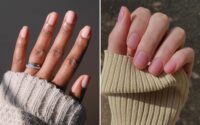Press-on nails are convenient — but risky
Is it time to press on from press-ons?
Fashionistas with flimsy nails are turning to faux finger flair as convenient press-on nails make a comeback in the beauty market, allowing nails to appear manicured even when they can’t make it to the salon.
The quick set is a lot quicker and cheaper than professional acrylic and gel types, with more versatility in trending nail designs than a typical salon tech can muster.
But that convenience comes at a cost, according to experts who warn that press-on nails come with hidden health risks that many beauty buffs don’t know.
“Risks for constant use of press on nails include damage to the nail from the removal process, allergic reactions to the glue or nails themselves, and risk of infection if proper hygiene is not maintained while wearing them,” Dr. Connie Yang, cosmetic dermatologist at PFRANKMD by Dr. Paul Jarrod Frank told The Post.
The application process of press-on nails includes cleaning the nail beds, pushing away at your cuticles, applying glue or a nail adhesive sticker and firmly pressing the designed nail onto yours. Within 15 minutes, you have a new full set.
Infections
Health issues such as infections can arise when people do not follow the proper nail application procedure, because they apply the press-on to a dirty nail bed.
“If the press-ons are applied over damaged or dirty nails, there is an increased risk of bacterial infections,” Yang added. “If moisture gets trapped between the press-on and natural nail, it can create an environment for fungal growth.”
As beautiful as press-on nails can be, when the nails start to lift more bacteria festers on the nail bed.
“This could happen just from everyday handwashing as [the press-on nail is] loosening up a little bit or if the adhesive isn’t applied to a clean nail,” Dr. Jasmine Rana, the director of the nail disorders clinic at Stanford Health Care, recently explained to Huff Post.
Allergic reactions
Press-on nails are secured with adhesive glue applied directly to the nails to keep them from falling off — a major fear for many press-on nail newbies.
Many people tend to slather the nail bed with glue to ensure no mishaps, but the excessive glue could trigger an allergic reaction.
“Those who have an allergy to adhesives or materials used in the nails can develop allergic reactions that manifest as redness, itching, swelling or rash around the nail area. Even those without an allergy can develop one over time if the body becomes sensitized to any of the materials in the adhesive or press-on nail,” Dr. Yang shared.
Many adhesive ingredients that irritate the skin and cause allergic reactions contain alcohol, cyanoacrylate or photo-bonded methacrylate, noted the National Library of Medicine.
“The most common contact allergen in nail glue is methacrylates such as methyl methacrylate and hydroxyethyl methacrylate, which can cause a localized rash or irritation,” the dermatologist noted.
Mani lovers could also risk developing hand eczema, revealed Dr. Rana. Hand eczema is a type of contact dermatitis that forms because of chemical irritants in the environment explained the National Eczema Association.
“So, what that means is … if you touch your face or your neck, it can show up in those areas. We’ve seen it on the eyelid, the face, the neck, the arm,” Rana added.
An alternative to harmful adhesive glue is adhesive nail stickers, HEMA (2-Hydroxyethyl methacrylate)-free nail polish or hypoallergenic nail glue.
“Always conduct a patch test before applying the glue to the entire nail to check for any adverse reactions,” suggests Yang.
Nail bed breakage
The nail takedown is more complex than the installation, but many people are quick to snatch the glued nail off once a few start to fall off, which leads to damaged nails.
“To minimize trauma and damage to your natural nail, I recommend soaking the fingers in acetone or a mixture of warm water and dish soap for 10-15 minutes to allow the glue and press-on to soften and loosen,” Dr. Yang said.
Removing press-on nails can result in nail plates separating from the nail bed, weak and brittle nails prone to splitting, and peeling or chipped nails.
“Do not force it,” Yang states. “If you are feeling resistance, soak for a little bit longer and continue this process until they release easily. You can also consider applying a little cuticle oil at the edge of the press-on to help with the slip.”
Gel-curing press on nails
Another application hack that has done more harm than good is gel-curing press-on nails, in which the adhesive is activated with a UV or LED lamp.
However, if the nails are not dried completely for the directed time frame of 30 to 60 seconds, according to PopSugar, an allergic reaction could be triggered by the chemicals involved in curing.
“If you incompletely cure it, even though it may look solid, if it’s not, then unfortunately, we’re seeing a lot of rising rates of allergy,” Rana said.
Many TikTokers promoted this concept because it made the cured nails last longer compared to adhesive glue and stickers.
“I think that’s an area that we need to be a little careful about because there have been a lot of allergies from incomplete curing,” concluded Dr. Rana.


